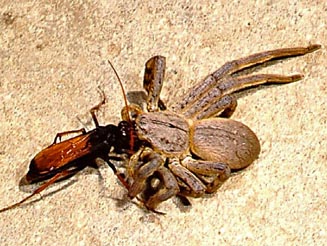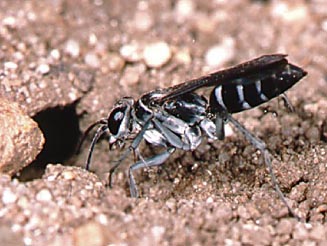|
Spider predators and
parasites
Back to spider home
Spiders (and insects) are hosts and prey to various animals and insects such as
acrocerid flies,
pompilid wasps,
mantispids, other spiders
(such as the cannibal spider) and insects, other
arthropods such as centipedes, certain reptiles, amphibians, birds and mammals.
Spiders commonly seen at the mercy of a wasp are the rain
spiders, Palystes and baboon spiders, Theraphosidae.
Females of various wasp species locate their prey and sting
them. This paralyses the prey but does not kill them. The paralysed prey is then
carried or dragged
to the nest that in some cases is prepared before prey capture. This often involves enormous effort. The
prey is then stored in the nest and once the nest is sufficiently stocked, the
wasp lays her eggs. The eggs hatch and the larvae then have live food on which
to feed. The prey lasts as long as required for the wasp larva to mature and
dies by the time the wasp larva pupates.
 |
 |
|
Spider wasp, Tachypompilus ignitus
dragging an immobilized Palystes spider to her nest. [images H.
Robertson, Iziko ©] |
 |
 |
|
Pompilidae wasp with
immoblized spider. [image N. Larsen ©] |
Pompilidae wasp digging a
nest. [image N. Larsen ©] |
With most species of the
Pompilidae (spider-hunting wasps), the female wasp lays
only one egg on a single spider. The larger the species of wasp, the larger the
spider required. The size of the spider prey determines whether the egg will
give rise to a male or female wasp. Smaller prey results in an unfertilised and
male-producing egg and larger prey in fertilised and female-producing egg.
After stinging its prey, the pompilid wasp drags its paralysed prey to a
nesting site. The wasp does this by grasping the immobilised spider by an
appendage such as a chelicerus (jaw) or leg, and drags it backwards over the
ground, face to face with its prey. Once the nesting site has been reached, the
prey is hidden about 25 cm from it and nest excavation begins. This the female
wasp does this with her front legs that are well equipped with a row of stout
spines that serve as efficient rakes. The front legs alternate and the abdomen
is held up to allow the excavated material to pile up behind the wasp. Once the
burrow is deep enough, the wasp drags the prey backwards into the nest and
places it facing towards the burrow entrance. A single egg is then laid on the
spider's abdomen.
This done, the pompilid wasp emerges, grooms herself and then proceeds to
close the burrow. All but the cell containing the egg and spider is filled with
earth. The wasp backs into the burrow, draws in the previously excavated soil,
passes it underneath her body and using her legs, packs it into place behind
her. As she packs, she moves forward, out of the burrow. Once the burrow is
filled in, the wasp proceeds to tamp down the earth using her abdomen. Flexing
at the "knees", the body and antennae vibrate so rapidly they become a
blur of activity and the sound is clearly audible. Great care is then taken to
level off the entrance of the burrow and the wasp intermittently flies up and
does a short circuit to inspect her site from the air, and goes back and makes
the necessary improvements. If not satisfied with her site inspection, she bites
earth from a quarry site next to the nest and spreads out the earth, tamping it down
all the time. Finally, loose debris is scattered on the site and she then grooms
herself again and flies off. In her life of a few weeks, the female pompilid
wasp will construct further nests.
In the darkness of its underground cell, the pompilid wasp egg hatches after
about 2 days and eats all the soft tissue of the spider, starting with the
abdomen and eventually leaving only the hollow cephalothorax and legs. After
about 7 days, It then spins a silken cocoon and pupates within, and emerges as
an adult wasp the following summer.
With other wasp species the egg is laid on the spider after which the spider continues to function while the wasp larva
feeds on it. Eventually the spider dies and the wasp larva pupates. There is
also an interesting scenario of a manipulative wasp
(not a local species) that lays her egg on a spider host. The spider continues going about its
normal life weaving normal webs. However, on the evening of the night that the
parasitic wasp larva finally kills its host, the spider is induced by the larva to weave a different web -
a web made specifically to accommodate the wasp pupa safely. After that, the
spider is consumed, the larva then moults and pupates, suspended from a custom
made web.
References
- Gess, F. W. and Gess, S. K. 1980. Spider vanquishers: the
nesting of Tachypompilus ignitus (Smith) and Batozonellus fuliginosus
(Klug). The Eastern Cape Naturalist, Number 69: 4-7.
Text by Margie Cochrane and Norman
Larsen ©
|
